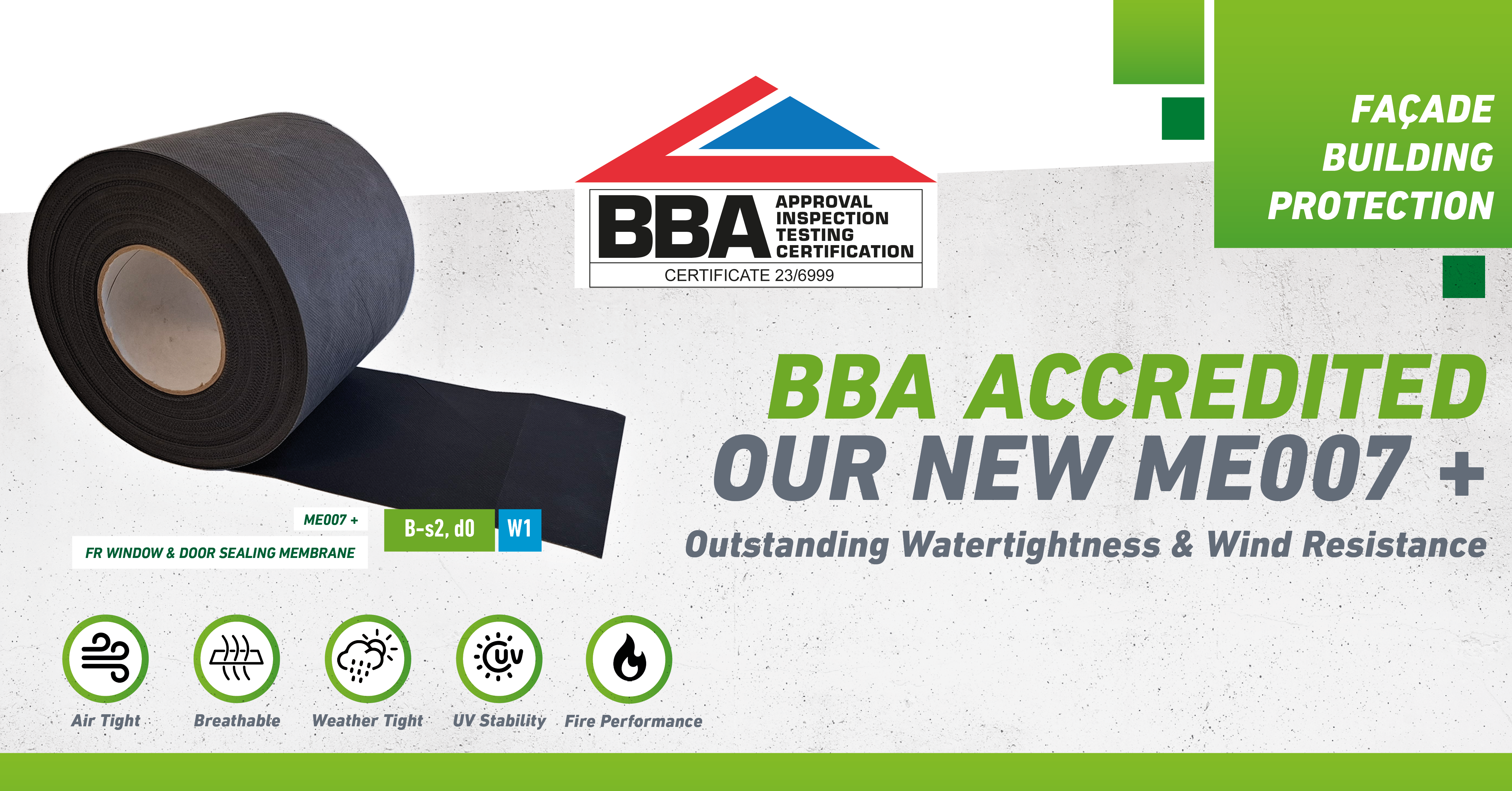Why should windows breathe?
The provision of a weather and airtight seal around the perimeter of windows and doors in a façade is typically achieved by correctly specifying and installing a suitable membrane before the final cladding is attached. There has been considerable focus on the specification and use of these membranes on construction sites since the recent updates to Approved Document B (ADB). Approved Document B requires that any membrane used in an external wall construction has a minimum reaction to fire Class B-s3, d0 in accordance with EN 13501-1. As well as achieving the requisite fire performance, it is critical that the appropriate level of weather protection is also provided, as this is the most common cause of warranty claims within the construction industry.
Sealing membranes should always be assessed for both water resistance and weathertightness. Both properties sound very similar but are measured in different ways. The water resistance of sealing membranes is tested in accordance with EN 1928 where the membrane is subject to a static head of water at a pressure of 2 kPa over an extended 24 hour period. The requirement is that no water penetrates the membrane over a 24 hour test duration in order to achieve a Class W1+ performance. Weathertightness is determined in accordance with EN 1027, which although originally intended as a means of testing assembled windows and doorsets, is now commonly used to test the performance of perimeter seals. In this method, the perimeter seal is applied around a window before being subjected to water sprayed under a pulsating pressure to simulate wind driven rain, a minimum performance of 600 Pa is required.
In addition to the fire and water/weather resistance performance of the sealing membrane, there is a further critical factor which should not be overlooked, relating to vapour and moisture control through the external wall and joint.
With a UK climate, the transmission of warm, moist air will be prominently from the inside to the outside of a building and therefore window and door interfaces should be designed to allow the escape of unwanted moisture or condensation to the external environment. The basic principle of the inside of the joint being ‘tighter’ than the outside should always be considered and appropriate membranes specified to satisfy this approach. When two membranes are used in the wall or around the window, the internal membrane must be more vapour tight than the external one. The recommended ratio is that the external membrane should be at least ten times more vapour open than the internal one. This will create a positive pressure gradient which in turn ensures that moisture movement is always from the inside to the outside of the wall construction. If this orientation is reversed or the ratio not observed, for example by installing a vapour tight membrane as the external seal, interstitial condensation could occur within the joint, causing mould growth and potential structural damage. This principle applies to the whole façade design and is not just specific to the window interfaces, as the potential for damage is relevant to both.
Traditionally, EPDM membrane has been specified for this type of sealing application, but with a surge in the availability of fire classified membranes to the market, specifiers, main contractors and warranty providers are now favouring these new membrane products, especially for use on ‘relevant’ or Higher Risk Buildings (HRB’s).
EPDM continues to be used as a generic term for any window sealing membrane, this unfortunately often leads to confusion and poorly specified solutions. A membrane which has a fire performance of Class B or better, is not ‘EPDM’, this is because true EPDM is actually a particular grade of rubber which has a fire performance of Class E and has a relatively high vapour resistance. Therefore EPDM or so-called EPDM alternatives do not typically comply with the ‘inside tighter than out’ principle as outlined above and therefore can compromise the performance of the window interface.
Whilst the water vapour transmission properties of a window sealing membrane can vary, they should always be vapour open when compared to the specified internal membrane and more importantly meet the 10:1 rule. The above principle is based on basic building physics and endorsed by CWCT in their technical publications, it is also the most recognised approach followed widely throughout Europe.
In conducting ‘due diligence’ when considering the specification of window sealing membranes, the following criteria should provide the focus:
- Be subject of recognised third party accreditation.
- For ‘relevant’ or ‘HRB’s’ be a minimum Class B-s3, d0 or better to EN 13501-1.
- Be tested as a system, including when tested to EN 13501-1, with the relevant specified adhesive.
- Should be as vapour tight as necessary but as breathable as possible.
- Follow the 10:1 inside to out rule for vapour transmission.
- Water resistance to Class W1+ when tested for 24 hours.
- Weathertight to minimum 600 Pa.
- Permanently UV resistant when used in open rainscreen cladding applications.
- Airtight where the air control layer is required on the external side of a building.
- Compatibility confirmed with all relevant substrate types and associated façade membranes.
Tremco CPG UK has been supplying a wide range of façade and window sealing membranes and associated products for over 75 years. Our philosophy for best practice in specifying and applying window membranes is in line with the above guidance and our illbruck FR Window & Door Sealing Membrane (Black) – ME010 meets all the listed criteria. The product’s performance is proven by its success since its introduction to the market, with current sales to-date of > 3 million linear metres!
Approved Document B has created a huge demand for appropriately fire classified façade and window membranes and whilst the basic performance characteristics for the former are well defined, the same basic principles can be applied to window sealing membranes, such as reaction to fire, weathertightness/water resistance and vapour transmission. illbruck FR Window & Door Sealing Membrane (Black) – ME010 is the product of choice to satisfy all of these requirements.











